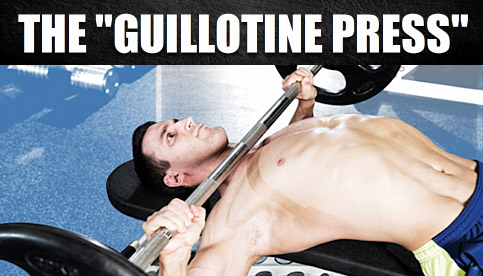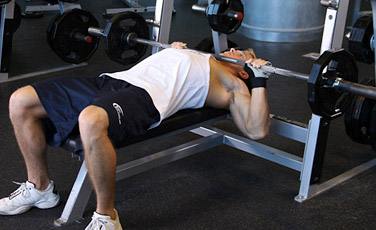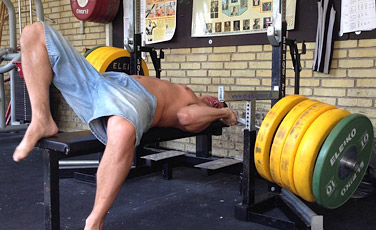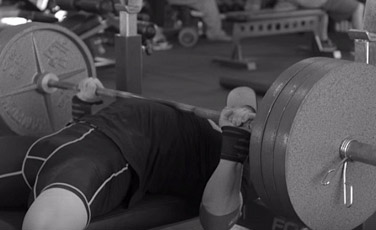THE DANGERS OF THE “GUILLOTINE PRESS”

The guillotine press (also referred to as the “Gironda neck press”) is a chest exercise made famous by old-school bodybuilder Vince Gironda. He was well-known for developing a variety of unique bodybuilding training techniques that are still used to this day.
It’s not the most common exercise that you’ll see being performed in the gym, but enough readers have asked for my opinion on it that I figured it was worth writing a blog post on.
More specifically, I want to address two major reasons why I don’t recommend including the guillotine press in your training plan.
With all due respect to the “Iron Guru,” my opinion is that the risks of this movement outweigh the rewards, and you’ll be better off by excluding the guillotine press from your workouts and opting for safer pressing variations.
What Is The Guillotine Press?

The guillotine press is a bench pressing variation used to target the chest, except with two main modifications…
The first difference is the bar path.
Rather than bringing the bar down to your lower chest as you would during a standard barbell bench press, you’ll instead lower it down to your neck.
The second difference is the position of the elbows.
Rather than tucking your elbows slightly inward toward your body, you’ll instead hold onto the bar with a wider grip and flare your upper arms directly out to your sides so that they’re perpendicular to your torso.
The goal of these two modifications is to reduce the activation of the front delts and triceps during the exercise and shift more of the emphasis onto the pecs.
The truth is that these two modifications actually do work well for their intended purpose.
By flaring your upper arms straight out to your sides and lowering the bar higher up on your body, you actually will maximize the recruitment of the chest by shifting the line of pull into a more effective position.
However, bottom line effectiveness is only as good as the safety of the exercise, and injury prevention should always be treated as a primary concern in your workout plan.
Always remember…
Your ability to train hard and build ongoing muscle size and strength hinges on the fact that you’re healthy enough to do so in the first place.
When you’re completely free of aches and pains this may be an easy lesson to dismiss, but trust me, the second you’re hit with an injury you’ll instantly see just how crucial this really is.
It doesn’t matter how great a particular lift is in terms of muscle stimulation; if that lift puts a disproportionate amount of strain on your joints (or is just flat out dangerous altogether), then it’s still not going to be a wise option for you over the long term.
When it comes to the guillotine press, there are two big problems you’re dealing with…
The 2 Main Dangers Of The Guillotine Press

The first danger is pretty obvious, and it’s the simple fact that you’re lowering a heavy loaded barbell directly above your neck.
If you’re a beginning lifter then this is going to be an extremely dangerous thing to do, and even as an advanced trainee it’s still far from a smart idea. (Like the “thumbless” or “suicide” grip I included in my common bench press mistakes post.)
You can never predict with certainty what might happen in the middle of any given set, and if you were to tweak something mid-rep or under-estimate your strength with a certain weight, having that bar directly in line with your throat is nothing short of a death wish.
In my view this is reason enough to steer clear of the guillotine press, even if you do have a spotter there to assist you.
The second danger is having your elbows fully flared out to your sides as you press and lower the bar.
This does shift more tension onto the chest as I mentioned before, but it also forces your shoulders into an extreme internally rotated position which in turn places a lot of stress on your rotator cuffs.
You may not experience any problems the first time you perform the guillotine press (or even the second, third, or fourth) but that stress will continue to accumulate over time and could set you up for some real problems in the long run.
You really don’t want to mess around when it comes to injuries as I mentioned before, and the shoulders are one area you especially want to protect since they’re involved in pretty much every major upper body exercise you perform.
So, it’s for those two reasons that I would suggest avoiding the guillotine press and opting for safer pressing variations.
I’m of course not saying that you’re guaranteed to get hurt with this exercise, but the risk/reward equation just doesn’t justify it in my view.
If you absolutely insist on performing the guillotine press as part of your workouts and have already made the decision to ignore the advice in this article, then at the very least you should be performing it using dumbbells.
You’ll still get the same (or better) muscle building stimulus that way, and even though your shoulder joints will remain at risk, at least you won’t die from the bar crashing down on your throat.
However, a much better plan is to just perform your bench presses and dumbbell presses in the proper, safe way.

That means:
- Tucking your elbows in toward your sides at roughly a 45 degree angle in order to protect your shoulders.
- Lowering the bar down to your lower chest, right around nipple level.
Doing so will hugely reduce your risk of neck and shoulder injuries while at the same time allowing you to target your pecs effectively for ongoing chest gains.
Read my tips on how to eliminate bench press shoulder pain to learn more about injury prevention.
If you found this article helpful, make sure to sign up for your FREE custom fitness plan below...




